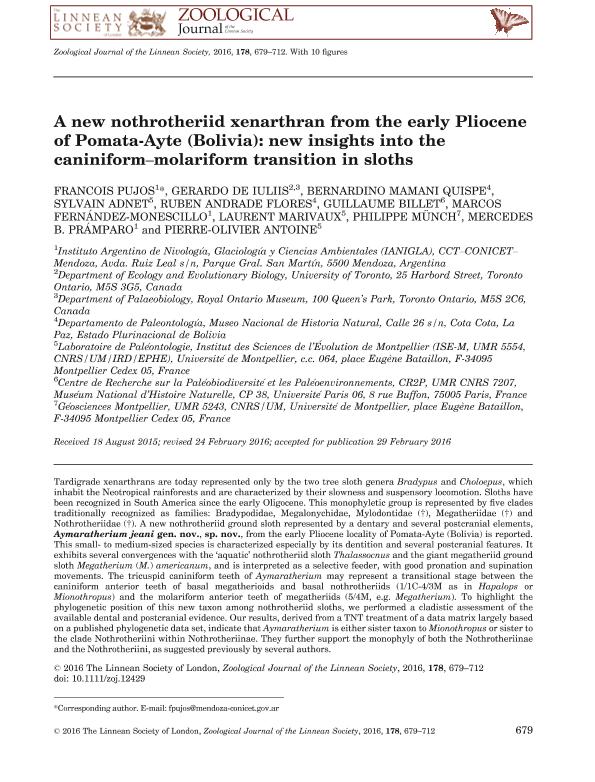Artículo
A new nothrotheriid xenarthran from the early Pliocene of Pomata-Ayte (Bolivia): New insights into the caniniform–molariform transition in sloths
Pujos, François Roger Francis ; De Iuliis, Gerardo; Mamani Quispe, Bernardino; Adnet, Sylvain; Andrade Flores, Ruben; Billet, Guillaume; Fernández Monescillo, Marcos; Marivaux, Laurent; Münch, Philippe; Pramparo, Mercedes Beatriz
; De Iuliis, Gerardo; Mamani Quispe, Bernardino; Adnet, Sylvain; Andrade Flores, Ruben; Billet, Guillaume; Fernández Monescillo, Marcos; Marivaux, Laurent; Münch, Philippe; Pramparo, Mercedes Beatriz ; Antoine, Pierre Olivier
; Antoine, Pierre Olivier
 ; De Iuliis, Gerardo; Mamani Quispe, Bernardino; Adnet, Sylvain; Andrade Flores, Ruben; Billet, Guillaume; Fernández Monescillo, Marcos; Marivaux, Laurent; Münch, Philippe; Pramparo, Mercedes Beatriz
; De Iuliis, Gerardo; Mamani Quispe, Bernardino; Adnet, Sylvain; Andrade Flores, Ruben; Billet, Guillaume; Fernández Monescillo, Marcos; Marivaux, Laurent; Münch, Philippe; Pramparo, Mercedes Beatriz ; Antoine, Pierre Olivier
; Antoine, Pierre Olivier
Fecha de publicación:
11/2016
Editorial:
Oxford University Press
Revista:
Zoological Journal of the Linnean Society
ISSN:
0024-4082
e-ISSN:
1096-3642
Idioma:
Inglés
Tipo de recurso:
Artículo publicado
Clasificación temática:
Resumen
Tardigrade xenarthrans are today represented only by the two tree sloth genera Bradypus and Choloepus, which inhabit the Neotropical rainforests and are characterized by their slowness and suspensory locomotion. Sloths have been recognized in South America since the early Oligocene. This monophyletic group is represented by five clades traditionally recognized as families: Bradypodidae, Megalonychidae, Mylodontidae (†), Megatheriidae (†) and Nothrotheriidae (†). A new nothrotheriid ground sloth represented by a dentary and several postcranial elements, Aymaratherium jeani gen. nov., sp. nov., from the early Pliocene locality of Pomata-Ayte (Bolivia) is reported. This small- to medium-sized species is characterized especially by its dentition and several postcranial features. It exhibits several convergences with the ‘aquatic’ nothrotheriid sloth Thalassocnus and the giant megatheriid ground sloth Megatherium (M.) americanum, and is interpreted as a selective feeder, with good pronation and supination movements. The tricuspid caniniform teeth of Aymaratherium may represent a transitional stage between the caniniform anterior teeth of basal megatherioids and basal nothrotheriids (1/1C-4/3M as in Hapalops or Mionothropus) and the molariform anterior teeth of megatheriids (5/4M, e.g. Megatherium). To highlight the phylogenetic position of this new taxon among nothrotheriid sloths, we performed a cladistic assessment of the available dental and postcranial evidence. Our results, derived from a TNT treatment of a data matrix largely based on a published phylogenetic data set, indicate that Aymaratherium is either sister taxon to Mionothropus or sister to the clade Nothrotheriini within Nothrotheriinae. They further support the monophyly of both the Nothrotheriinae and the Nothrotheriini, as suggested previously by several authors.
Palabras clave:
ANATOMY
,
BOLIVIA
,
EARLY PLIOCENE
,
NOTHROTHERIIDAE
,
PHYLOGENY
,
PILOSA
,
XENARTHRA
Archivos asociados
Licencia
Identificadores
Colecciones
Articulos(IANIGLA)
Articulos de INST. ARG. DE NIVOLOGIA, GLACIOLOGIA Y CS. AMBIENT
Articulos de INST. ARG. DE NIVOLOGIA, GLACIOLOGIA Y CS. AMBIENT
Citación
Pujos, François Roger Francis; De Iuliis, Gerardo; Mamani Quispe, Bernardino; Adnet, Sylvain; Andrade Flores, Ruben; et al.; A new nothrotheriid xenarthran from the early Pliocene of Pomata-Ayte (Bolivia): New insights into the caniniform–molariform transition in sloths; Oxford University Press; Zoological Journal of the Linnean Society; 178; 3; 11-2016; 679-712
Compartir
Altmétricas



